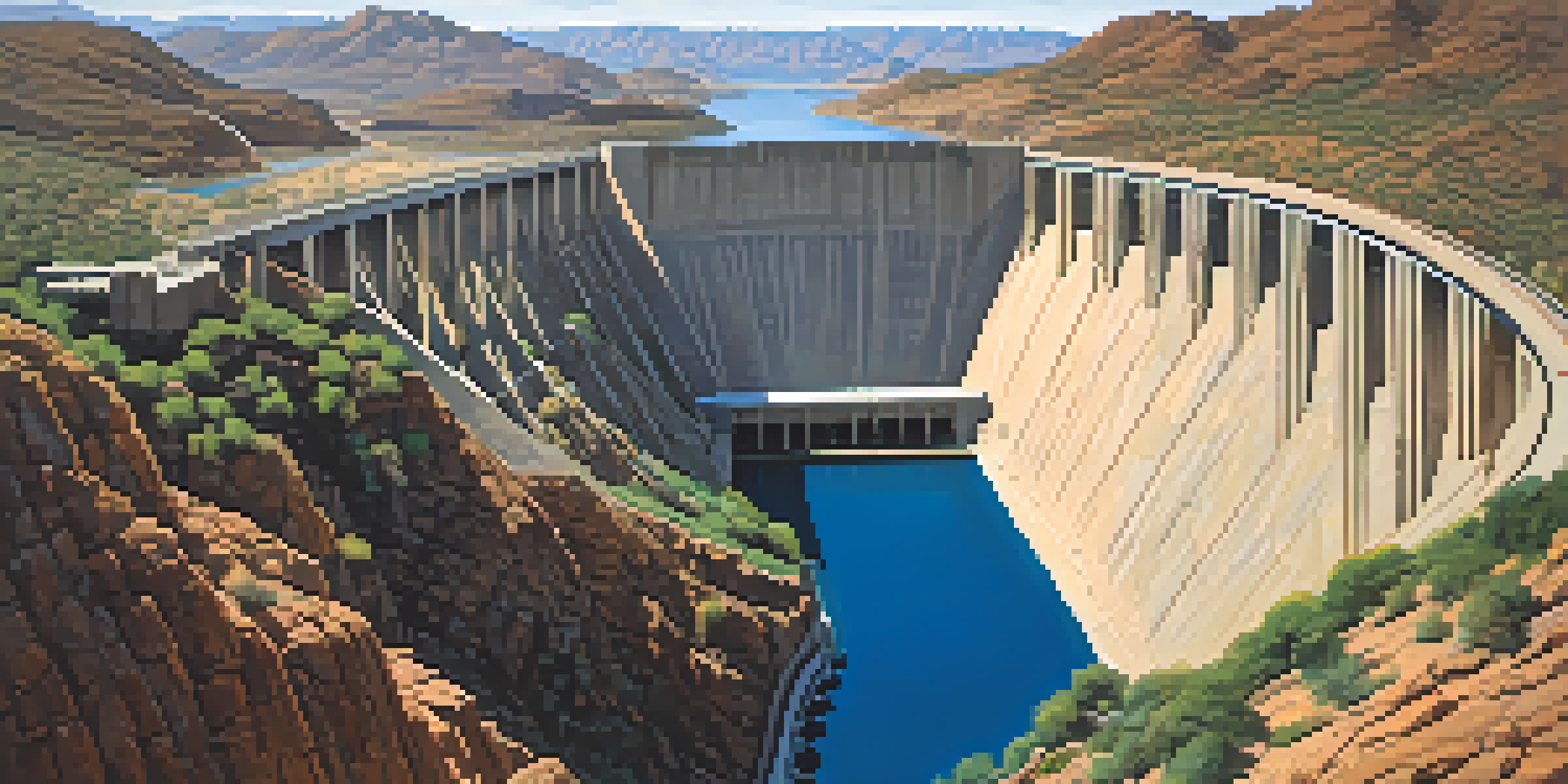Early 20th Century Water Infrastructure in Arizona

The Importance of Water in Early 20th Century Arizona
Water was a lifeline for Arizona in the early 1900s, as the state grappled with its arid landscape. The availability of water determined where communities could thrive, influencing agricultural productivity and urban development. This necessity drove innovation and infrastructure projects that shaped the state's future.
Water is the driving force of all nature.
As more settlers arrived, the demand for reliable water sources increased dramatically. Farmers needed irrigation for crops, while towns required potable water for growing populations. This led to the establishment of various water management systems, including reservoirs and aqueducts, as communities sought to harness and distribute water effectively.
In this context, the early 20th century became a pivotal era for Arizona, marked by ambitious projects. The connection between water availability and economic growth was clear, pushing local governments and private entities to invest in infrastructure that would sustain life in the desert.
Key Infrastructure Projects of the Early 1900s
Among the most notable projects was the construction of the Roosevelt Dam, completed in 1911. This monumental structure not only provided much-needed water storage for irrigation but also generated hydroelectric power, showcasing the multipurpose benefits of water infrastructure. It became a cornerstone for the Salt River Project, supporting agriculture and urban growth in the surrounding areas.

Another significant advancement was the development of the Arizona Canal, which began in the late 19th century and was expanded into the 20th century. This canal system allowed water from the Colorado River to reach the desert regions, facilitating agricultural expansion and providing water to burgeoning cities like Phoenix. The canal's construction was a testament to the ingenuity needed to manage water resources effectively.
Water Infrastructure Fueled Growth
In early 20th century Arizona, the development of water management systems was crucial for agricultural expansion and urbanization, enabling communities to thrive in an arid landscape.
These projects laid the groundwork for a vast network of water management systems, reflecting the priorities of the time. They not only addressed immediate water needs but also established frameworks for future developments, ensuring that Arizona could continue to grow in the face of environmental challenges.
Challenges Faced in Water Management
Despite the advancements, the journey was fraught with challenges. The harsh climate of Arizona posed significant hurdles, as droughts were not uncommon, leading to water shortages and conflicts over rights. The competition for water resources between agricultural users and urban areas often led to tensions that required careful management.
We forget that the water cycle and the life cycle are one.
Additionally, the technology of the time was limited, making the construction and maintenance of water infrastructure a significant endeavor. Engineers and workers faced difficulties in navigating the rugged terrain and ensuring that systems could withstand natural elements. This necessitated a blend of creativity and resilience, as communities rallied together to overcome obstacles.
The early 20th century also saw growing awareness of the need for sustainable practices. As water became increasingly scarce, discussions began about conservation methods and the importance of balancing human needs with environmental considerations, foreshadowing future debates on water management strategies.
The Role of Government in Water Infrastructure
Government involvement was crucial in the development of water infrastructure during this period. The federal government played a pivotal role through initiatives like the Reclamation Act of 1902, which aimed to support irrigation projects in arid regions. This act facilitated funding and resources for large-scale water projects, helping Arizona harness its water potential.
State and local governments also took an active role, establishing water districts and regulations to manage resources effectively. These entities worked collaboratively with farmers and urban planners to prioritize water allocation, ensuring that both agricultural and residential needs were met. Their efforts helped to create a structured approach to water management.
Government's Key Role in Water Projects
Government initiatives, such as the Reclamation Act of 1902, were vital in supporting large-scale water infrastructure projects that helped manage resources effectively and sustain Arizona's growth.
These collaborative efforts laid the foundation for future water policies and regulations, demonstrating the importance of governance in addressing water issues. The partnerships formed between various levels of government and communities were instrumental in building a sustainable water infrastructure that could support Arizona's growth.
Impact of Water Infrastructure on Agriculture
The development of water infrastructure had a transformative effect on agriculture in Arizona. With reliable irrigation systems in place, farmers could cultivate crops that were previously deemed impossible to grow in the arid climate. This led to a diversification of agricultural practices and an increase in crop yields, significantly boosting the local economy.
As water became more accessible, the agricultural landscape shifted from subsistence farming to commercial production. Farmers began to grow cash crops like cotton and citrus, which not only supported their livelihoods but also contributed to Arizona’s economic development. The increased agricultural output positioned Arizona as a key player in national markets.
However, this agricultural boom came with its own set of challenges, particularly concerning water management. As farming practices expanded, so did the demand for water, which necessitated ongoing investments in infrastructure to ensure sustainable practices. This cycle of growth and resource management remains a critical aspect of Arizona's agricultural story.
Urbanization and Water Needs in Early Arizona
As Arizona's cities began to grow, the demand for water shifted dramatically. Urbanization brought an influx of residents, leading to increased pressure on existing water supplies. Cities like Phoenix and Tucson had to adapt quickly, expanding their water infrastructure to meet the needs of their growing populations.
This urban expansion often meant that water systems had to be adapted or entirely overhauled. New pipelines, treatment facilities, and distribution networks were developed to ensure that urban areas had access to clean and reliable water. These developments were crucial in sustaining not only the population but also the associated industries and services that accompanied urban growth.
Legacy of Sustainable Practices
The early infrastructure developments not only transformed Arizona's agricultural and urban landscapes but also laid the groundwork for ongoing discussions about sustainable water management in the face of climate change.
The relationship between urbanization and water infrastructure during this period highlights the interconnectedness of society and resources. As cities evolved, their water management systems became more sophisticated, laying the groundwork for future innovations in urban planning and resource management.
Lasting Legacy of Early Water Infrastructure in Arizona
The early 20th century water infrastructure developments set the stage for Arizona’s future. The systems and projects initiated during this time became the backbone of modern water management practices. They established a legacy that continues to influence how Arizona addresses its water needs today.
Moreover, the lessons learned during this period regarding sustainability and resource management are more relevant than ever. As climate change presents new challenges, the importance of efficient water use and thoughtful planning has taken center stage in discussions about Arizona's future.

Today, the infrastructure developed in the early 1900s is still in use, albeit with necessary upgrades and modifications. The enduring impact of these early projects is a testament to the foresight of those who recognized that water is not just a resource—it's a vital component of life in the desert.